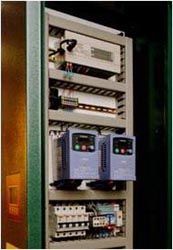|
Automating film
wrapping at full stretch
 Stretch
wrapping is a commonplace enough process in any manufacturing or
distribution business using palletised loading, but the task of
automating the wrapping procedure relies on sophisticated control.
Which is why shrink and stretch wrapping specialist Nissen Packaging
selected Hitachi drives and PLCs from HID Limited for its latest
automated wrapping machines. Stretch
wrapping is a commonplace enough process in any manufacturing or
distribution business using palletised loading, but the task of
automating the wrapping procedure relies on sophisticated control.
Which is why shrink and stretch wrapping specialist Nissen Packaging
selected Hitachi drives and PLCs from HID Limited for its latest
automated wrapping machines.
Nissen's latest Easywrapper machine has two axis drives with 0.55kW
AC induction motors controlled by Hitachi L100 inverters. One motor
controls a rotary turntable on which the pallet to be wrapped is
placed. The second controls the rise and fall of the roll of stretch
film material on its vertical linear axis using a chain drive.
A Seeka photocell is employed to detect whether a pallet is loaded
on the machine and then to identify when the film roll has reached
the top of the pallet. Once the top of the pallet is detected, a
routine enables the film carrier to lower slightly to allow a top
sheet to be placed on the pallet before completing the wrapping.
Alternatively, where no top sheet is required, the roll continues
to rise a discrete amount to give a finishing overlap wrap to the
top edge of the loaded pallet. The logic functions of the programs
are controlled by a Hitachi EC28HRP PLC with 28I/O. Surprisingly,
for what appears to be a relatively simple process, all 14 outputs
are employed in the Nissen machine.
The two Hitachi L100 inverter drives are pre-programmed by Nissen
to each give seven speeds and there are five recipes also pre-programmed
to provide for just about any wrapping sequence. The recipes include
different speeds for single and double wrapping, different film
overlaps and so forth. Programs are selected via a simple MMI from
Horner, which has a plain English menu operation. Clearly, if the
recipes provided are insufficient for an application, the machine
can be reprogrammed by a supervisory engineer or by Nissen if required.
A further level of control is provided by fitting an electromagnetic
clutch to the film roll holder that enables film tension to be adjusted
via a simple potentiometer knob adjacent to the operator panel.
The Hitachi L100 inverter drives and the Hitachi EC28 PLC are interfaced
with the MMI. The Hitachi L100 inverter drives have an RS422 communications
port and there are seven inputs, of which five are programmable,
and two programmable outputs as well as an alarm output. Access
to the terminal rails is by opening the hinged front case.
Nissen Packaging commented, "HID has been extremely helpful and
supportive both during the design stages of the machine and afterwards.
The company has also assisted in automating the machine through
its PLC programming and work carried out to identify and then interface
with the Horner MMI." Unusually, the Easywrapper is made largely
from standard off-the-shelf components from UK sources.
Hitachi L100 inverter drives are used on Nissen's semi-automatic
machines and there is also a larger Easywrapper machine that uses
0.75kW Hitachi L100 inverters. In conjunction with the Hitachi inverter
drives, Nissen are using Hitachi's latest Windows-based programming
software for the Hitachi L100 inverters, making multiple programme
storage for various machines possible.
Nissen began in the UK as a sales subsidiary of a Swedish film packaging
company in 1971. Six years ago, the company was established as an
independent British company as the result of a management buyout.
About three years later Nissen designed and manufactured its first
semi-automatic stretch film wrapping machines at its Leighton Buzzard
premises.
Return
to Case Studies Menu
|

